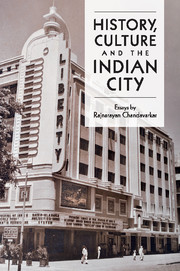Book contents
- Frontmatter
- Contents
- Acknowledgements
- Publisher's note
- Introduction by Dr Jennifer Davis, Wolfson College, University of Cambridge
- Bombay's perennial modernities
- Sewers
- Peasants and proletarians in Bombay city in the late nineteenth and early twentieth centuries
- State and society in colonial India
- Religion and nationalism in India
- From neighbourhood to nation: the rise and fall of the Left in Bombay's Girangaon in the twentieth century
- Historians and the nation
- Urban history and urban anthropology in South Asia
- Aspects of the historiography of labour in India
- Postscript by Professor David Washbrook, Trinity College, University of Cambridge
- Bibliography of the published works of Rajnarayan Chandavarkar
- Index
- References
Religion and nationalism in India
Published online by Cambridge University Press: 17 March 2010
- Frontmatter
- Contents
- Acknowledgements
- Publisher's note
- Introduction by Dr Jennifer Davis, Wolfson College, University of Cambridge
- Bombay's perennial modernities
- Sewers
- Peasants and proletarians in Bombay city in the late nineteenth and early twentieth centuries
- State and society in colonial India
- Religion and nationalism in India
- From neighbourhood to nation: the rise and fall of the Left in Bombay's Girangaon in the twentieth century
- Historians and the nation
- Urban history and urban anthropology in South Asia
- Aspects of the historiography of labour in India
- Postscript by Professor David Washbrook, Trinity College, University of Cambridge
- Bibliography of the published works of Rajnarayan Chandavarkar
- Index
- References
Summary
From the 1980s onwards, communal tensions and antagonisms in India appeared to increase and violence occurred on a larger scale. Not only did communal riots become more frequent but, in addition, the violence increasingly took on the character of pogroms often conducted on an unprecedented scale. At times, political parties or paramilitary groups acting with the assistance of the police and the state attacked civilians with seemingly an unconstrained ferocity. Waves of violence swept through Gujarat and the North Indian states of Uttar Pradesh and Bihar in the 1980s. There were several days of brutal violence against Sikhs in Delhi and elsewhere in 1984, following the assassination of Mrs Indira Gandhi. Bombay and a few other towns, including Surat in Gujarat, witnessed systematic and, for some days, seemingly unlimited violence against Muslims after the activists of the Hindu nationalist Sangh Parivar destroyed the Babri Masjid, a sixteenth-century mosque which they claimed had been built on the site of the birthplace of the Hindu god, and epic hero, Ram. Perhaps worst of all was the pogrom conducted against Muslims in Gujarat in February and March 2002.
Moreover, this communal antagonism coincided with a shift in the terms of public debate. Until the 1970s, the language of development, nation building and socialism had provided the dominant motifs in Indian political discourse. In the 1980s, there was a perceptible shift towards the definition of the nation in explicitly cultural or communal terms, as a predominantly Hindu nation.
- Type
- Chapter
- Information
- History, Culture and the Indian City , pp. 103 - 120Publisher: Cambridge University PressPrint publication year: 2009



